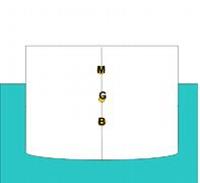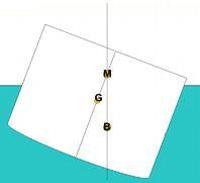|
Vincent Pica
Chief of Staff, First District, Southern Region (D1SR)
United States Coast Guard Auxiliary
|
|
What!? How Small a Wave Can Capsize My Boat!?
|
Certainly, the tragedy in Oyster Bay on July 4, 2012, points to the urgent need for more understanding by boat captains of capsizing. There is a tremendous amount of data on “righting moments”, centers of buoyancy and gravity, thanks to the US Navy and the US Coast Guard, amongst many institutions that literally live and die by these metrics. We’ve also seen a couple of columns here about wind and waves, which are the agents of capsizing (see SSP, “Wave Theory and Practice”, 3/23/11 and “Wave Theory and Practice, Part II”, 7/21/10.)
|
Most of us understand “center of gravity” (G) instinctually. But what is the center of buoyancy? The center of buoyancy (B) is the center of the volume of water which the hull displaces. When a ship is stable, the center of buoyancy is vertically in-line with the center of gravity of the ship. So, as long as the center of gravity (G), pushing the boat down, is above the center of buoyancy (B), pushing the boat up, we’re good. How good? That is a very good question and as with many good questions, it requires more information to answer properly. Take a look at diagram A.
What is that “M” sitting up there above our trusty center of “G”ravity and the center of “B”uoyancy? That is something very important called the “M”etacenter. The metacenter remains directly above the center of buoyancy regardless of the heeling (tilting caused by external factors like wind or waves) or listing (tilting caused by internal factors such as poorly stowed cargo or on-boarding of water by wind or waves) of a boat. Take a look at Diagram B. If you are starting to worry about the distance between “G” and “M”, called the “Metacentric height” (or “GM” in naval architecture parlance), you’ve catching on quickly. The math gets pretty complicated from here but suffice it to say that the ability of the boat to right herself, i.e,, her “righting arm” or “righting moment”, has a lot to do with GM. The larger the GM acting as a lever, the better.
|
 |
| Diagram A - Courtesy of US Coast Guard - click to enlarge |
|
|
 |
| Diagram B - Courtesy of US Coast Guard - click to enlarge |
|
|
Sail boats are designed to operate with a higher degree of heel (greater GM) than motor boats but the principles are exactly the same.
From This to Wave Height?
Yes. You can infer that your motor boat’s center of gravity and center of buoyancy can’t be too far apart when the entire distance from the keel to the floor boards is probably something like 2’ or 3’. Think of her draft. It isn’t a big number, even for a 40’er. No reason to panic but you now realize that M, G and B can’t be that far apart – which means that GM just can’t be that great either. And GM is a surrogate for the righting ability of your boat.
But wait. I’ve been out in some pretty steep seas and I think the boat handled it well. Yes, because studies conducted by the Society of Naval Architects and Marine Engineers (SNAME) determined that 3 things must exist for a capsizing to occur:
1. The boat is broadside to the wave. Yes, a boat can be pitch-poled (tossed end-over-end), but the size of the wave needed to do that greatly exceeds the size of the smaller wave needed to knock a boat down when broadside to a wave.
2. The boat is struck by a breaking wave.
3. Wave height must exceed a certain percentage of the boat’s length.
At this point the wave contains enough energy to overcome a boat’s righting moment.
So, what is that “certain percentage?” At only 30% of your boat’s length, (about 6’ from tough to crest for a 20’ boat), things enter directly into the realm of high danger. At 60%, it is nearly certain that one wave will catch you and then you, the crew and the boat may well come to grief.
So, before trying to transit these inlets and bars that control much of our access to the open sea (see SSP, “Mastering the Inlet”, 12/12/07), think about just how much of a righting arm your boat can possibly have…
|
One Last Thought…
No one wants to “pile on” when a tragedy ensues. A family that loses 3 young members is in pain that is immeasurable. But lest more tragedy befalls us as a community, as you change the weight of the boat, you lower the center of gravity. This makes the boat “more tender”, i.e., it reduces the righting arm – which makes the boat easier to capsize. With 27 people on a 34’ boat, you have to wonder just how much that righting arm was reduced…
|
BTW, if you are interested in being part of USCG Forces, email me at JoinUSCGAux@aol.com or go direct to the D1SR Human Resources department, who are in charge of new members matters, at DSO-HR and we will help you “get in this thing…”
|
| <-- click there to tweet, post or otherwise distribute to the 'net
Have something to add, ask or pass along? Pls do so below! I promise a response.
|
|